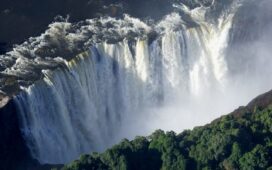Recently updated on March 27th, 2024 at 01:36 am
Experience the wild side of Africa and let the Mara mystify with her untamed beauty. Kate Webster takes you into the wild, from dawn to dusk in one of Africa’s most iconic playgrounds.
As dawn breaks, there was a stirring happening. The air was cool, but charged with an electricity that cuts through the static and leaves you feeling on edge. The smell of the bush danced on the air, a sweet mix of florals, rustic earthy scents and petrichor from the morning dew.
The sun’s golden glow blanketed the plains, its warmth still developing with each minute that passed. The sound of morning birds filled the air in a symphony of calls. There was movement on the horizon. It was my first visit to the Maasai Mara in Kenya. Affectionally known as the Mara, it is a large game reserve in Narok County, which continues to the Serengeti National Park in Mara Region, Tanzania.
The Maasai Mara was named in honour of the ancestral inhabitants of the area, the Maasai people. They described the area when looked at from afar, “Mara”, which is Maa (Maasai language) for “spotted,” an apt description for the circles of trees, scrub, savanna, and cloud shadows that mark the area. Covering some 1,510 km2, the Maasai Mara stretches for as far as the eye can see.
Even then, it is only a fraction of the Greater Mara ecosystem, which covers some 25,000 km2 and includes the following Group Ranches: Koiyaki, Lemek, Ol Chorro Oirowua, Olkinyei, Siana, Maji Moto, Naikara, Ol Derkesi, Kerinkani, Oloirien, and Kimintet.
If I were a vulture circling and looking across the land, I would see the Serengeti Park to the south, the Siria escarpment to the west, and Maasai pastoral ranches to the north, east and west. I would see the Sand, Talek River and Mara River all sustaining the reserve with fringing shrubs and trees.
Access
The day earlier, I boarded a small Air Kenya DeHavilland Twin Otter 300 plane at Wilson Airport in Kenya’s capital of Nairobi and flew east for about two hours to land at Olkiombo Airstrip. Due to the size of the plane, luggage allowance was limited to a soft bag weighing no more than 15kg. The flight was where the excitement started, cruising over the countryside speckled with townships and farms and expanses of terrain that was just empty. Not for the uneasy flyer, the flight took a few pitstops along the way, each time landing on a dirt runway, which seemed in the middle of nowhere.
Camp
With the dying light, it was straight from Olkiombo Airstrip to my accommodation, Mara Expedition Camp. Mara Expedition Camp sits on a small bend in the Ntiakitiak River, where a thick riverine forest meets the unending savannah in the north-central section of the Maasai Mara.
A small camp with just five tents accommodating up to ten guests, the intimacy of this camp is a main drawcard. There was a real feel of authenticity here with an air of yesteryear in the design, which draws stylistic reference from the old, authentic expedition camps of the colonial era
Constructed in the spirit of mobility and non-permanence out of deference to the wilderness, which surrounds it, the camp is tented safari style. However, these tents are far from those you buy at your local camping store. The tastefully appointed tents take glamping off the scale, and you hardly feel like it is a tented camp. Set at ground level and shaded by the forest canopy, the tents forego fancy amenities, but still leave you wanting for nothing.
The oversized bed sat centre of the main room and gave a view out to the bush. A separate bathroom included an antique camp shower that pulls from a brass bucket, adding to the overall experience. The tent was decorated with an eclectic yet co-ordinated assembly of what early explorers may have carried with them – brass chandeliers, old Indian campaign chests, rich leather and hardwood furniture – combined with rich textiles and soft cottons
Into the wild
Waking before the sun, I was ready to embark on my first game drive of my stay. It was late October and still relatively cold in the mornings. Armed with an artillery of cameras and lenses, freshly brewed coffee and a traditional Maasai shuka cloth that is affectionately known as the “African blanket” to keep me warm.
There was just myself and JP, the game ranger, in the open-air vehicle as we bounced off into the breaking dawn.
It didn’t take me long to grasp that this is a place of learning, where Africa teaches lessons that will change the way you view the world in one of the most incredible classrooms on the planet – the incomparable Maasai Mara. A place where lions and other big cats own the night; a place where hippos stake claim to vast territories; a place where we submit to the supreme power of wild Africa and take our lead from Mother Nature.
The golden glow of the sky faded as the sun rose higher in the sky and the slight stirring of wildlife during the breaking dawn became more active. There seemed to be a sense of urgency to start the day. Just a few kilometres out from the camp and that supreme power of the wild was upon me.
Giraffes walked gracefully across the plains, curiously stopping every so often to glance around and survey the area. Grand majestic elephants paraded slowly past, the younger elephants trailing playfully behind. Wild dogs called in the distance, an excited chatter like that of children running off to play.
Herds of wildebeest congregated as if attending a morning board meeting. Mixed with them were dazzles of zebra and I am told these are the stragglers that did not venture on the great migration. Described as the greatest show on Earth, the Great Migration is an overwhelming, humbling and quite simply amazing wildlife experience.
Every year, millions of wildebeest, zebras and gazelles combined gather on the vast plains of the Serengeti in Tanzania to begin their race towards greener grazing lands. Following the rains, they head north towards the Maasai Mara before about-turning and dashing south again. It’s a sprint for survival, covering a total of over 1,800 miles, and the journey is incredibly tough, where only the strong survive
Survival is a battle that is played out daily in the Mara, and from the serene start to my morning, I was about to be quickly awoken by such a battle. A lioness crouched in the long grass, her body twitched in anticipation. Although her stare was fixed on the target, she was aware of everything that was going on around her. The gazelle unfortunately was not, otherwise it would have realised what immediate danger it was in and the fate that lay ahead. It had been only minutes that I had been watching the lioness’s stealth, but it felt like hours, and the anticipation numbed my body. I had to remind myself to breathe.
A lighting burst from the lioness began the hunt as she erupted from the silence of her camouflage, the attack was on. The gazelle realised all too late. In the distance I saw a flurry of movement in the scrub and grass, the impala’s hind leg jutted into the air and the tumble of these two animals in this wrestle for life stirred up dust and debris that floated gently in the air above the chaos that unravelled below.
As we drove closer to the kill, an overwhelming sense of emotions engulfed me. The initial scene of tragedy turned to one of hope as the lioness was soon joined by her small family, with more of the pride arriving to feast on the meal. It then becomes clear to me the meaning behind ‘the circle of life’, the loss of one animal’s life in order for another animal to live.
This circle is the essence of Africa. It’s what keeps the continent’s heart beating; it’s what keeps it alive. A beat that is rooted deep in the soil that supplies life to the age-old Baobab trees; a beat that echoes beyond the vast plains that feed such amazing and unique animals; a beat that lives on in the souls of those who live there and a beat that will always remain in my heart after my first visit to the Maasai Mara.
As my day came to an end, I revelled in the most memorable African sunset. The yellow-orange-red and violet hues of sunset was intense, yet offered a calming warmth. Like a great big romantic fire in the sky, the sun dipped behind the horizon as if an orchestral symphony was quieting down. The sun’s rays waved goodbye like an old friend, but you know you will see them again.











